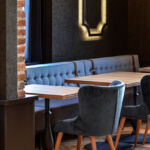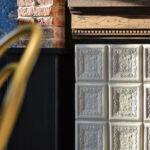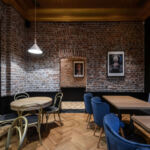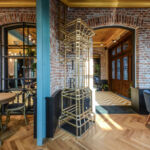Excelsior Restaurant: A Remarkable Transformation of a House
Project's Summary
A House and the Name: Excelsior Restaurant Project by Yellow Office Architecture
Located on Alexandru Macedonski Street in Craiova, a house has undergone a remarkable transformation to become the Excelsior Restaurant. The task at hand was to find a suitable name for this new culinary hotspot, and an intriguing connection was made between the houses on the street and the volumes of a renowned Romanian writer, Alexandru Macedonski. This connection led to the decision to name the restaurant Excelsior, after a poetry volume written by Macedonski in 1895, the same year the house was built.
When the project began, the house was in a dilapidated state, with no plaster on its walls and ceilings. While the original intention for the house remains unknown, the architects saw great potential in preserving its authentic appearance. The exposed layers of the house became a testament to its history, and it was decided to keep things as they were. The presence of the original structure and texture added a unique charm to the space, making it an opportunity to create something truly special.
Upon entering the restaurant, one can immediately observe the distinct layers and frames that define the space. Each vertical section reveals three clearly separated registers - the floor, walls, and ceiling. These registers transition from a solid and compact bottom layer to a diaphanous and bright top layer. However, it is the middle layer, the binder between the extremes, that truly encapsulates the house's history. The walls without plaster, bearing witness to the past, are framed by the other two registers, creating a harmonious composition.
The entire space was carefully designed as a suite of frames. As the interior carpentry was removed, pastel metal frames were introduced to mark the passages between rooms. These frames serve as an intermediary register, connecting the enclosing walls to the neighboring room. Furthermore, the frames extend beyond their original purpose, framing other objects and providing glimpses into different spaces. The black paneling on the floor establishes a connection with the walls, while the ceiling is elegantly framed by a perimeter profile in each room. Even the wall-mounted lamps receive their own frames, ensuring every element is clearly outlined yet subtly connected to others.
This sense of correspondence extends to the furniture as well. The flat layers are supported by upholstered seats and rectangular-shaped sofas, while thin frames find their counterpart in curved wooden chairs. Some furniture pieces reinterpret elements reminiscent of a bygone era, such as a stove shaped only by its edges and metal frames that evoke the classic doors of old. The bar, covered in terracotta tiles, features a rough wooden cornice on top, which highlights the next layer – vertical ornamental glass panels. The interplay between the enameled, glossy, cold tiles on the lower register and the cool industrial air of the glass layer behind the bar is seamlessly bridged by the warm, wooden middle register.
Just as the marble or oak flooring defines the lower register, the retro-inspired furniture and golden lighting pendants contribute to the luxurious ambiance of the ceiling. It is this juxtaposition of the two mirrored registers, each striving to coexist, that creates an eclectic atmosphere within the restaurant. The contrast is beautifully melded in a neutral median layer, resulting in a space that captivates visitors with its unique charm and harmonious design.
The Excelsior Restaurant project, brought to life by the talented architects at Yellow Office Architecture, stands as a testament to the beauty and potential that lies within forgotten spaces. By embracing the layers and frames of the house, the architects have created a dining experience that seamlessly blends history with contemporary design.
Read also about the Timeless French Country Architectural Masterpiece by Stout Design project






